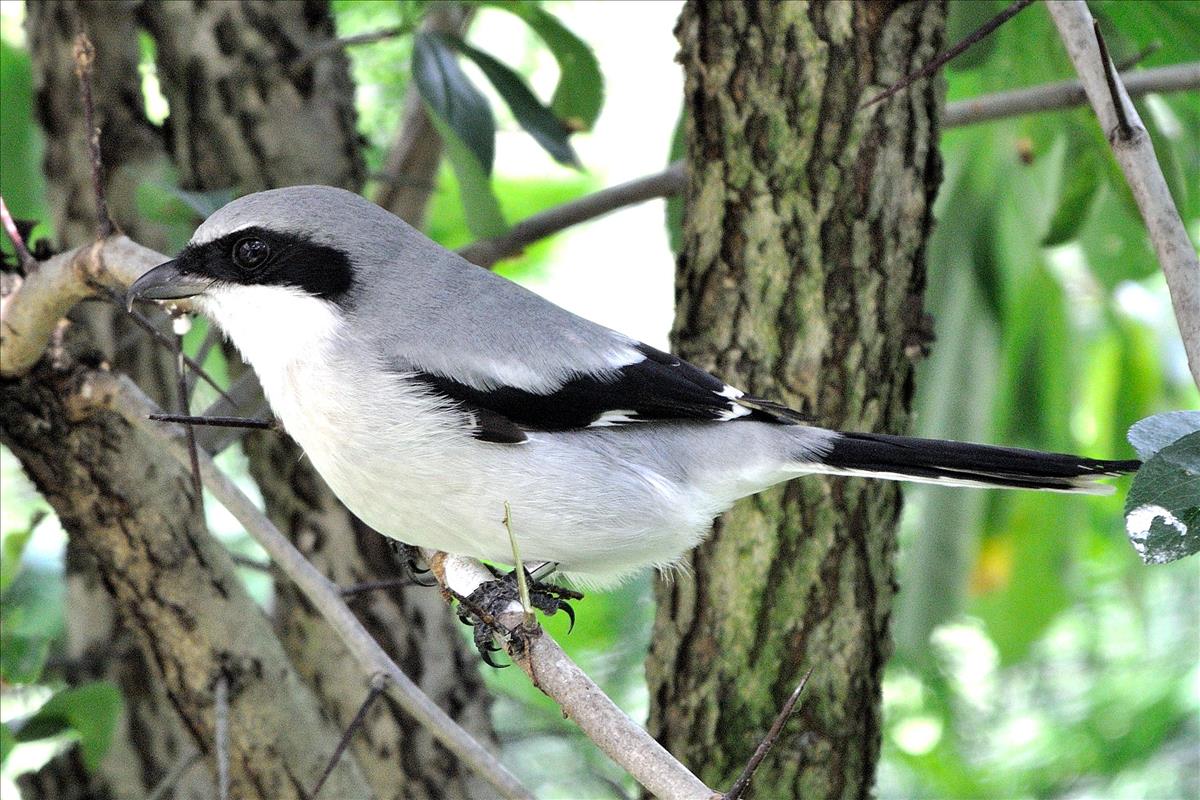Viewable


Bird
Location at the Zoo
Americas
Global Range
North America
Eastern loggerhead shrike
Lanius ludovicianus migrans
Order: Passeriformes
Family: Laniidae
Genus: Lanius
The main identifier is the black, bandit like mask extending from the bill to the rear ear coverts. The large block (or logger) head is a slate grey that continues down the back to the rump. Underparts are whitish to pale grey. Wings are black split by a broad band of white, conspicuous in flight, at the base of the primaries. Secondaries and tertials are tipped white. Scapulars transition into white towards their tips. A mostly black tail has white tips except in the center and white outer feathers. Legs and feet are black. Claws are sharp and strongly curved. Toes have large distal pads. The stubby black bill is hooked. A very narrow, white supercilium runs above the mask. Eyes are dark brown. Juveniles head and upperparts are tinged brown. Mask is a darker brown. Wing patch is buffy.
Length: 18 to 22 cm.
Wingspan: 28 to 32 cm.
Weight: 43 to 54 g.
Length: 18 to 22 cm.
Wingspan: 28 to 32 cm.
Weight: 43 to 54 g.
Conservation Status: IUCN

Distribution
There are 11 subspecies of loggerhead shrike in North America, two of which are found in Canada: the Prairie loggerhead shrike, Lanius ludovicianus excubitorides and the eastern loggerhead shrike Lanius ludovicianus migrans. Formerly, the eastern loggerhead shrike ranged from Manitoba to New Brunswick and as far south as northeastern Texas, western North Carolina and Maryland. Today it exists only in small pockets. It faces extirpation in Canadait may soon no longer exist in the wild here. It has disappeared from New Brunswick and Quebec. In Ontario, there are five widely separated locations where a few breeding pairs still can be found. Loggerhead shrikes that breed in Canada migrate to southern locations for the winter.In southern Ontario, another species of shrike, the northern shrike, Lanius excubitor, can be seen from October to the beginning of April. The eastern loggerhead shrike appears in southern Ontario in early April and is normally gone by September. This subspecies of loggerhead, Lanius ludovicianus migrans can be very difficult to distinguish from the northern shrike, Lanius excubitor. Differences are slight, but the eastern loggerhead shrike has a larger mask and their song is slightly more melodious.
Habitat
Loggerhead shrikes require open areas with very low vegetation. Grasslands, active pasture, golf courses, parks, and mowed roadside are selected with scattered trees or shrubs like hawthorn, red cedar, or spruce nearby. These provide perches with wide-ranging views for foraging, nesting, and sanctuary. The remaining sites in Ontario appear to be short grass prairie, found in karst rock formations where cattle or other grazers keep the vegetation short. These "prairies" have small trees/ bushes, usually hawthorn or cedar sparsely distributed across the area. Hawthorn, barbed wire and sometimes cedar are used to impale their prey/trophies.Diet
They consume grasshoppers, beetles, crickets, spiders, and small vertebrates. In terms of biomass, vertebrates are often its main energy source particularly in winter when insects are scarce. Mice, small birds, lizards, frogs, and snakes are taken as well as carrion including road kill. The feeding habits most closely resemble a small bird of prey such as a kestrel. The shrike does not have the strong grasping feet of a bird of prey; they compensate by impaling their prey on a spine and use this as the secure "grasp" so they may tear bite sized pieces off the carcass. This is unique to this family of birds. Lanius, the genus name, comes from the Latin laniare, to tear. It is sometimes referred to as the butcherbird.Reproduction
Eastern loggerhead shrikes migrate from the USA to Canadian breeding areas in April. Males prepare a cache of impaled food, the size of which indicates to a prospective mate his potential to feed a family. Behaviourally, the male can initiate nest building. The female will then modify it or will go and find a place she prefers. The female always completes the building. When building her nest, concealed beneath a canopy, the female weaves twigs, bark and grass tightly to protect the nest from cold and rain. She lines the cup with grasses and moss.Five or six eggs are laid and incubated for 17 to 20 days. The male provides a cache of impaled food nearby. Born altricial and weighing three grams, hatchlings grow to 45 grams, almost adult weight, in two weeks. Soon flying, juveniles remain at home another three to five weeks to learn foraging skills. The ability to impale is innate, but practice makes them more efficient. They are able to breed the following spring. One brood is produced per year, although on occasion they have two broods, but this is rare. Lifespan is up to six years.
Adaptation
Shrikes are the only songbirds (passerines) that hunt like a bird of prey. Seeking vertebrates; L. l. migrans perches solitarily on a branch, fence, or utility wire that provides a wide view of an open field. It swoops down and inflicts a sharp blow to a victims head. With feet and talons too small for killing, it uses the angle between the hooked bill and the tomial tooth on the upper mandible as a notch to snap the victims neck. Its strong beak can carry prey almost its own weight to an impaling site such as a thorn or barbed wire. Impaling is energy efficient, allowing for easy tearing. The carcass can be left impaled until the family is ready to eat again. Sitting and waiting as a foraging technique also saves energy since a shrike perches for 80% of the day. Hawking and hovering to catch insects, takes much more energy.The eastern loggerhead shrikes black mask absorbs light, lessening reflection that distorts sight. The eyes protrude slightly to improve binocular vision.
This specie is highly territorial, threatening intruders with a bowing or flutter display, or harsh screeching (shrike has the same derivation as shriek). If an intruder doesnt leave, fighting often breaks out. Territories range from four to thirty hectares depending on quality, measured by the lowness of the vegetation and the availability of scattered trees and shrubs. During migration it covers 70 to 80 kilometres a day.
Threats to Survival
There is a great deal of speculation as to why these shrikes are declining in the wild. Possibilities include: the increase of field sizes that cuts out hedgerows and thus nesting sites; the increase in pesticides that decreases the food supply and may affect fertility/survivability of eggs; road kill; the overgrowth of pasture land by secondary growth and invasive species which changes the habitat to unsuitable for shrikes; increased predation due to cats and increased numbers of crows; disease (such as West Nile Virus) and also the change in habitat in their wintering range that reduces the fitness of the population to breed in the spring, if they survive at all. Overall, a loss in the general diversity of the region and its biodiversity is a major factor.Since 1991, efforts have been made to restore suitable habitat and, through captive-breeding programs, to release young birds back into the wild. Approximately 10% of the wild birds were captive born and released as part of the recovery program. (TZ is part of this).












